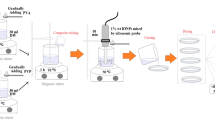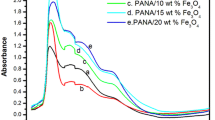We have studied the structure, microhardness, and thermomechanical properties of poly(styrenebutylacrylate)– magnetite hybrid composites, obtained by the method of suspension polymerization. We have established that composite grains are not susceptible to aggregation and have a spherical shape. By means of Raman spectroscopy, we have detected that, in the course of synthesis of a hybrid composite, simultaneously with the encapsulation of magnetite particles by polymeric shells, magnetite adsorption on the surface of composite grains takes place. We have also found the optimal interval of magnetite content (6.3 to 9.0 %) that provides the compaction of composites and enhancement of their mechanical strength as well as the temperatures of vitrification and flow.




Similar content being viewed by others
References
D. Wang, J. He, N. Rosenzweig, and Z. Rosenzweig, “Superparamagnetic Fe2O3 beads–CdSe/ZnS quantum dots core – shell nanocomposite particles for cell separation,” Nanoletters, 4, No. 3, 409–413 (2004).
H. Sawada, H. Yoshioka, T. Kawase, et al., “Preparation of magnetic nanoparticles by the use of self-assembled fluorinated oligomeric aggregates. A new approach to the dispersion of magnetic particles on poly(methyl methacrylate) film surface,” J. Fluorine Chem., 126, 914–917 (2005).
V. N. Vasyukov, V. P. Dyakonov, V. A. Shapovalov, et al., “Temperature-induced change in the ESR spectrum of the Fe3+ ion in polyaniline,” Low Temper. Phys., 26, No. 4, 265–269 (2002).
Z. Zhang and M. Wan, “Nanostructures of polyaniline composites containing nano-magnet,” Synth. Metal., 132, 205–212 (2003).
W. Xue, K. Fang, H. Qiu, et al., “Electrical and magnetic properties of the Fe3O4–polyaniline nanocomposite pellets containing DBSA-doped polyaniline and HCl-doped polyaniline with Fe3O4 nanoparticles,” Synth. Metal., 156, 506–509 (2006).
I. Ye. Opainych, O. I. Aksimentyeva, H. Szymczak, et al., “Polymer assisted fabrication and properties of nanocomposites with nonaggregated magnetic particles,” in: 5th International Workshop on Functional and Nanostructured Materials, Abstract Book, (Lviv, August 31–September 6, 2008), Lviv (2008), pp. 122–124.
I. E. Opainych and I. I. Maleev, A Method of Synthesis of Superfine Magnetite [in Ukrainian], Patent of Ukraine No. 62416А, Publ. 2003, Bull. No. 12.
W. Kraus and G. Nolze, PowderCell for Windows (Version 2.4), Federal Institute for Materials Research and Testing, Berlin (2000).
T. H. Keijser, J. I. Langford, E. J. Mittemeijer, and A. B. P. Vogels, “Use of the Voigt function in a single-line method for the analysis of X-ray diffraction line broadening,” J. Appl. Crystallogr., 15, 308–314 (1982).
E. V. Kuznetsov, S. M. Divgun, A. A. Budarina, et al., Practical Work in Chemistry and Physics of Polymers [in Russian], Khimiya, Moscow (1977).
V. P. Zakordons’kyi and R. V. Skladanyuk, “Thermomechanical properties and structure of epoxy-amine meshes formed in the presence of Aerosil,” in: Bull. Lviv Univ., Ser. Chem. [in Ukrainian], Issue 39 (2000), pp. 303–309.
I. A. Gorlovskii, A. M. Bocharova, and V. D. Suvorova, Laboratory Practical Work in Chemistry and Technology of Pigments [in Russian], Khimiya, Leningrad (1978).
M. E. Fleet, “The structure of magnetite,” Acta Crystallogr., Ser. B, 37, 917–920 (1981).
T. Liu, B. Christian, and B. Chu, “Nanofabrication in polymer matrixes,” Prog. Polym. Sci., 28, 5–26 (2003).
J. Lee and M. Senna, “Preparation of monodispersed polystyrene microspheres uniformly coated by magnetite via heterogeneous polymerization,” Colloid Polym. Sci., 273, 76–82 (1995).
M. H. Sonsa, F. A. Tourinho, and J. C. Rubim, “Use of Raman micro-spectroscopy in the characterization of MIIFe2O4 (M = Fe, Zn) electric double layer ferrofluids,” J. Raman Spectrosc., 31, 185–191 (2000).
V. F. Babich, M. T. Bryk, R. A. Veselovskii, et al., Filled Polymers: Physicochemistry of Multicomponent Polymeric Systems [in Russian], Naukova Dumka, Kiev (1986).
This work was partially supported by the Ministry of Science and Higher Education of Poland (grant No. 507 492438).
Author information
Authors and Affiliations
Corresponding author
Additional information
Translated from Fizyko-Khimichna Mekhanika Materialiv, Vol. 48, No. 1, pp. 89–94, January–February, 2012.
Rights and permissions
About this article
Cite this article
Opainych, I.E., Aksiment’eva, O.I., D’yakonov, V.P. et al. Structure and thermodeformation properties of polymer–magnetite hybrid composites. Mater Sci 48, 95–100 (2012). https://doi.org/10.1007/s11003-012-9477-y
Received:
Published:
Issue Date:
DOI: https://doi.org/10.1007/s11003-012-9477-y




